中国书法英文 chinese calligraphy
- 格式:pptx
- 大小:4.79 MB
- 文档页数:22
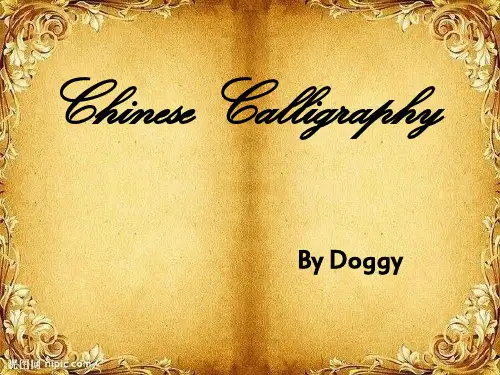
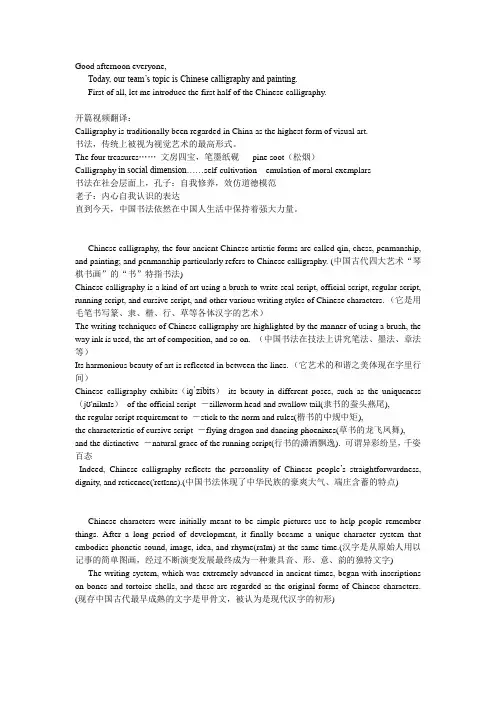
Good afternoon everyone,Today, our team’s topic is Chinese calligraphy and painting.First of all, let me introduce the first half of the Chinese calligraphy.开篇视频翻译:Calligraphy is traditionally been regarded in China as the highest form of visual art.书法,传统上被视为视觉艺术的最高形式。
The four treasures……文房四宝,笔墨纸砚pine soot(松烟)Calligraphy in social dimension……self-cultivation emulation of moral exemplars书法在社会层面上,孔子:自我修养,效仿道德模范老子:内心自我认识的表达直到今天,中国书法依然在中国人生活中保持着强大力量。
Chinese calligraphy, the four ancient Chinese artistic forms are called qin, chess, penmanship, and painting; and penmanship particularly refers to Chinese calligraphy. (中国古代四大艺术“琴棋书画”的“书”特指书法)Chinese calligraphy is a kind of art using a brush to write seal script, official script, regular script, running script, and cursive script, and other various writing styles of Chinese characters.(它是用毛笔书写篆、隶、楷、行、草等各体汉字的艺术)The writing techniques of Chinese calligraphy are highlighted by the manner of using a brush, the way ink is used, the art of composition, and so on. (中国书法在技法上讲究笔法、墨法、章法等)Its harmonious beauty of art is reflected in between the lines. (它艺术的和谐之美体现在字里行间)Chinese calligraphy exhibits(iɡˈzibits)its beauty in different poses, such as the uniqueness (jʊ'niknɪs)of the official script ―silkworm head and swallow tail(隶书的蚕头燕尾),the regular script requirement to ―stick to the norm and rules(楷书的中规中矩),the characteristic of cursive script ―flying dragon and dancing phoenixes(草书的龙飞凤舞), and the distinctive ―natural grace of the running script(行书的潇洒飘逸).可谓异彩纷呈,千姿百态Indeed, Chinese calligraphy reflects the personality of Chinese people’s straightforwardness, dignity, and reticence('retɪsns).(中国书法体现了中华民族的豪爽大气、端庄含蓄的特点)Chinese characters were initially meant to be simple pictures use to help people remember things. After a long period of development, it finally became a unique character system that embodies phonetic sound, image, idea, and rhyme(raɪm) at the same time.(汉字是从原始人用以记事的简单图画,经过不断演变发展最终成为一种兼具音、形、意、韵的独特文字) The writing system, which was extremely advanced in ancient times, began with inscriptions on bones and tortoise shells, and these are regarded as the original forms of Chinese characters. (现存中国古代最早成熟的文字是甲骨文,被认为是现代汉字的初形)Afterwards, Chinese characters went through numerous calligraphic styles: bronze inscriptions, official script, regular script, cursive script, running script, etc. (此后,汉字又经历了金文、隶书、楷书、草书、行书等不同的阶段)Chinese characters are usually round outside and square inside, which is rooted in ancient Chinese beliefs of an orbicularsky and a rectangular Earth. (汉字结构“内圆外方”,源于古人“天圆地方”的观念)The five basic strokes of Chinese characters are 一(the horizontal stroke), 丨(the vertical stroke), 丿(the left-falling stroke), 捺(the right-falling stroke), and 乙(the turning stroke). (汉字有五种基本笔画,即:横、竖、撇、捺、折)The four treasures of the study.文房四宝The writing brush, ink stick, ink stone, and paper were requisite('rekwɪzɪt)treasures in the study of the scholars of ancient China, and they are often referred to as the ―Four Treasures of the Study.(笔墨纸砚是中国古代文人书房当中必备的宝贝,被称为“文房四宝”)The writing brush and ink stick have been used by the Chinese to write and paint since 5,000 years ago.(用笔墨书写绘画在中国可追溯到五千年前)In the Qin Dynasty (221BC-206BC), people already used feathers('fɛðɚ)of different hardness and bamboo trunks to make brushes.(秦朝时已用不同硬度的毛和竹管制笔)During the Han Dynasty (206BC-220AD), man-made ink was used instead of natural ink. (汉代以人工制墨替代了天然墨)After paper was invented by the Chinese, bamboo slips, wooden tablets, brocade and silk, which originally functioned as writing surfaces, gradually faded out. (有了纸张以后,简牍锦帛逐失其用)The ink stone was first developed with the use of writing brushes and ink. (砚台则随笔墨的使用而发展)After the Song Dynasty(960AD-1279AD), the ―Four Treasures of the Study,particularly referred to hubi, the writing brush produced in Huzhou, Zhejiang province; huimo, the instick produced in Huizhou, Anhui province; xuan paper, a kind of paper produced in Xuanzhou, Anhui province; and duanyan, the ink stone made in Zhaoqing, Guangdong province(Zhaoqing was earlier called Duanzhou).Indeed, the ―Four Treasures of the Study have written the whole Chinese civilization, as it is.“文房四宝”到宋朝(960-1279)以后特指湖笔(浙江湖州)、徽墨(安徽徽州)、宣纸(安徽宣州)、端砚(广东肇庆,古称端州)。
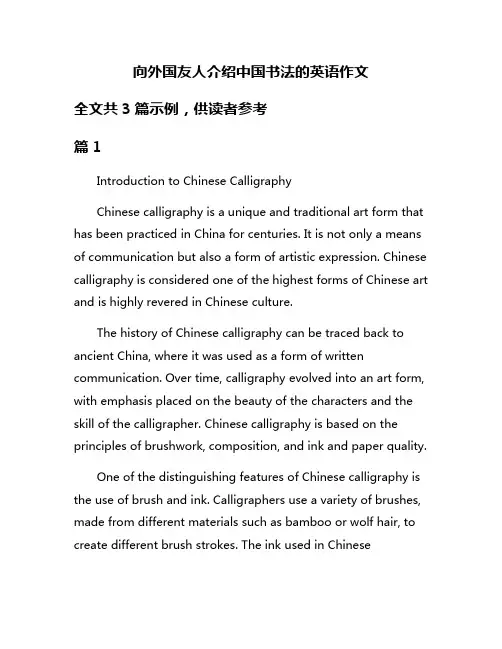
向外国友人介绍中国书法的英语作文全文共3篇示例,供读者参考篇1Introduction to Chinese CalligraphyChinese calligraphy is a unique and traditional art form that has been practiced in China for centuries. It is not only a means of communication but also a form of artistic expression. Chinese calligraphy is considered one of the highest forms of Chinese art and is highly revered in Chinese culture.The history of Chinese calligraphy can be traced back to ancient China, where it was used as a form of written communication. Over time, calligraphy evolved into an art form, with emphasis placed on the beauty of the characters and the skill of the calligrapher. Chinese calligraphy is based on the principles of brushwork, composition, and ink and paper quality.One of the distinguishing features of Chinese calligraphy is the use of brush and ink. Calligraphers use a variety of brushes, made from different materials such as bamboo or wolf hair, to create different brush strokes. The ink used in Chinesecalligraphy is typically black or dark brown and is made from soot or charcoal.The composition of Chinese calligraphy is also important. Calligraphers pay careful attention to the balance and harmony of the characters on the page. The size, shape, and spacing of the characters all play a role in creating a visually pleasing composition.In addition to brushwork and composition, the quality of the ink and paper used in Chinese calligraphy is also important. High-quality paper and ink help to enhance the appearance of the characters and ensure that the calligraphy lasts for a long time.Chinese calligraphy is a highly respected art form in Chinese culture. It is seen as a reflection of the calligrapher's personality and emotions. Calligraphy is often used in Chinese paintings, poetry, and other forms of art to enhance the overall aesthetic appeal.Overall, Chinese calligraphy is a beautiful and traditional art form that has been practiced for centuries. It is highly regarded in Chinese culture and has influenced many other forms of art around the world. If you are interested in learning more aboutChinese calligraphy, I highly recommend exploring this fascinating art form further.篇2Introduction to Chinese CalligraphyChinese calligraphy, also known as "shufa" in Chinese, is a traditional art form that has been practiced for thousands of years in China. It is considered one of the highest forms of visual art, along with painting and poetry, in traditional Chinese culture. Chinese calligraphy is not just a means of communication, but also a way of expressing one's emotions, thoughts, and personality.History of Chinese CalligraphyChinese calligraphy has a long history that dates back to ancient China. The earliest known examples of Chinese calligraphy can be traced back to the Shang Dynasty (c.1600-1046 BC). During the Zhou Dynasty (1046-256 BC), calligraphy began to take shape and became more formalized.In the Han Dynasty (206 BC-220 AD), a standard script called "lishu" was developed, which became the basis of modern Chinese calligraphy. Over the centuries, various styles of calligraphy emerged, such as clerical script, cursive script, andseal script, each with its own unique characteristics and aesthetic appeal.Features of Chinese CalligraphyChinese calligraphy is characterized by its use of brush and ink on paper or silk. The four essential tools of Chinese calligraphy are the brush, ink, paper, and inkstone. The brush is made of animal hair, such as goat, wolf, or rabbit, and can vary in size and shape. The ink is made from soot that is mixed with water and comes in solid form. The paper used for Chinese calligraphy is usually rice paper or Xuan paper, which can absorb ink well and give the strokes a smooth and flowing look.Chinese calligraphy is based on strokes that are made with the brush in a flowing and rhythmic manner. The quality of a calligraphic work is judged by the balance, harmony, and rhythm of the strokes, as well as the artist's skill in controlling the brush and ink. Each stroke in Chinese calligraphy is imbued with meaning and symbolism, and the arrangement of strokes on the paper reflects the artist's personal style and artistic sensibility.Styles of Chinese CalligraphyThere are five main styles of Chinese calligraphy, known as "wubi" in Chinese. These styles are based on historical scripts andhave been passed down through the generations. The five styles are:1. Seal script (zhuanshu): This is the oldest style of Chinese calligraphy, dating back to the Shang Dynasty. Seal script is characterized by its geometric and angular shapes, which are similar to the characters found on ancient seals and bronze inscriptions.2. Clerical script (lishu): This is a more formal and standardized style of calligraphy that was developed during the Han Dynasty. Clerical script is characterized by its straight and even strokes, which are easy to read and understand.3. Regular script (kaishu): This is the most common style of Chinese calligraphy, which is the standard script used in modern China. Regular script is characterized by its balanced and symmetrical strokes, which are easy to write and read.4. Running script (xingshu): This style of calligraphy is more cursive and flowing than regular script, with strokes that are connected and fluid. Running script is often used for informal writing and personal correspondence.5. Cursive script (caoshu): This is the most artistic and expressive style of Chinese calligraphy, with strokes that arehighly abstract and stylized. Cursive script is often used for poetry and other creative writings.ConclusionChinese calligraphy is a rich and vibrant art form that reflects the beauty and complexity of traditional Chinese culture. It is a way of expressing oneself through the written word, as well as a means of appreciating the aesthetic beauty of the Chinese language. Through the careful study and practice of Chinese calligraphy, one can gain a deeper understanding of Chinese history, culture, and philosophy. I hope this introduction to Chinese calligraphy has sparked your interest in this ancient and revered art form. Thank you for listening.篇3Introduction to Chinese CalligraphyChinese calligraphy, also known as "Shufa" in Chinese, is a traditional art form that has a long history dating back thousands of years. It is considered one of the highest forms of Chinese art and is highly revered in Chinese culture. Chinese calligraphy is not only a form of writing, but also a form of art that conveys the artist's emotions, thoughts, and spirit.Chinese calligraphy uses a brush, ink, and paper as its main tools. The brush is made of animal hair, usually from a goat, wolf, or rabbit, and the ink is made from grinding an ink stick against an ink stone and mixing it with water. Different brushes, inks, and papers can create different styles and effects in calligraphy.There are five main styles of Chinese calligraphy, each with its own unique characteristics and history. These styles are Seal Script (Zhuan Shu), Clerical Script (Li Shu), Standard Script (Kai Shu), Running Script (Xing Shu), and Cursive Script (Cao Shu). Each style has its own rules and conventions, but all styles focus on the beauty and harmony of the written characters.Chinese calligraphy is not only a form of art, but also a way of self-cultivation and meditation for many Chinese people. By practicing calligraphy, one can cultivate concentration, patience, and a peaceful mind. Calligraphy is also used in many traditional Chinese ceremonies and rituals, such as writing scrolls for auspicious events, creating seals for official documents, and inscribing poems on objects.In conclusion, Chinese calligraphy is a unique and ancient art form that embodies the beauty and culture of China. It is a form of writing that goes beyond mere words, but conveys the artist's emotions and spirit. To truly appreciate Chinese calligraphy, onemust understand its history, styles, and techniques. It is an art form that has stood the test of time and continues to be cherished by people all over the world.。
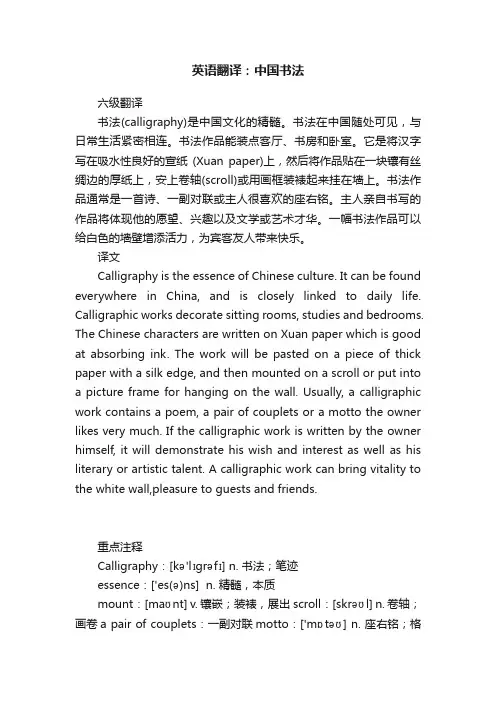
英语翻译:中国书法六级翻译书法(calligraphy)是中国文化的精髓。
书法在中国随处可见,与日常生活紧密相连。
书法作品能装点客厅、书房和卧室。
它是将汉字写在吸水性良好的宣纸(Xuan paper)上,然后将作品贴在一块镶有丝绸边的厚纸上,安上卷轴(scroll)或用画框装裱起来挂在墙上。
书法作品通常是一首诗、一副对联或主人很喜欢的座右铭。
主人亲自书写的作品将体现他的愿望、兴趣以及文学或艺术才华。
一幅书法作品可以给白色的墙壁增添活力,为宾客友人带来快乐。
译文Calligraphy is the essence of Chinese culture. It can be found everywhere in China, and is closely linked to daily life. Calligraphic works decorate sitting rooms, studies and bedrooms. The Chinese characters are written on Xuan paper which is good at absorbing ink. The work will be pasted on a piece of thick paper with a silk edge, and then mounted on a scroll or put into a picture frame for hanging on the wall. Usually, a calligraphic work contains a poem, a pair of couplets or a motto the owner likes very much. If the calligraphic work is written by the owner himself, it will demonstrate his wish and interest as well as his literary or artistic talent. A calligraphic work can bring vitality to the white wall,pleasure to guests and friends.重点注释Calligraphy:[kə'lɪgrəfɪ] n. 书法;笔迹essence:['es(ə)ns] n. 精髓,本质mount:[maʊnt] v. 镶嵌;装裱,展出scroll:[skrəʊl] n. 卷轴;画卷a pair of couplets:一副对联motto:['mɒtəʊ] n. 座右铭;格言demonstrate:['demənstreɪt] vt. 显示,展示vitality:[vaɪ'tælɪt ɪ] n.活力;生命力。
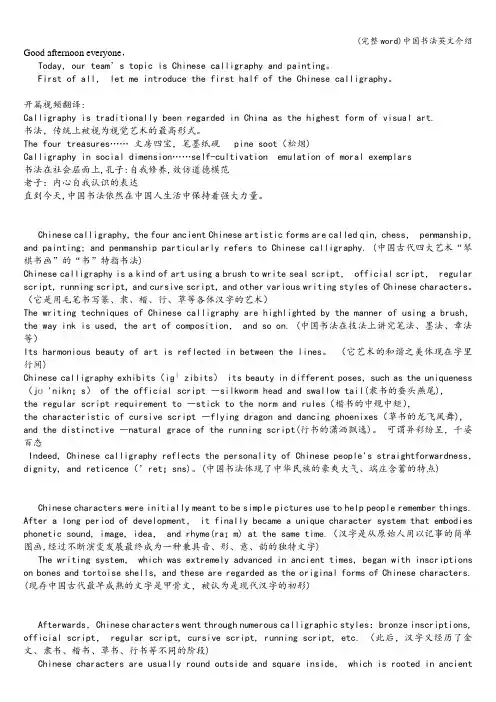
Good afternoon everyone,Today, our team’s topic is Chinese calligraphy and painting。
First of all, let me introduce the first half of the Chinese calligraphy。
开篇视频翻译:Calligraphy is traditionally been regarded in China as the highest form of visual art.书法,传统上被视为视觉艺术的最高形式。
The four treasures……文房四宝,笔墨纸砚 pine soot(松烟)Calligraphy in social dimension……self-cultivation emulation of moral exemplars书法在社会层面上,孔子:自我修养,效仿道德模范老子:内心自我认识的表达直到今天,中国书法依然在中国人生活中保持着强大力量。
Chinese calligraphy, the four ancient Chinese artistic forms are called qin, chess, penmanship,and painting; and penmanship particularly refers to Chinese calligraphy. (中国古代四大艺术“琴棋书画”的“书”特指书法)Chinese calligraphy is a kind of art using a brush to write seal script, official script, regular script, running script, and cursive script, and other various writing styles of Chinese characters。
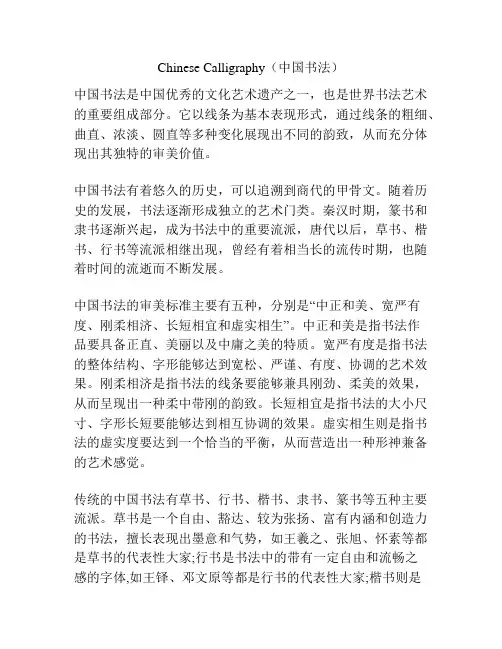
Chinese Calligraphy(中国书法)中国书法是中国优秀的文化艺术遗产之一,也是世界书法艺术的重要组成部分。
它以线条为基本表现形式,通过线条的粗细、曲直、浓淡、圆直等多种变化展现出不同的韵致,从而充分体现出其独特的审美价值。
中国书法有着悠久的历史,可以追溯到商代的甲骨文。
随着历史的发展,书法逐渐形成独立的艺术门类。
秦汉时期,篆书和隶书逐渐兴起,成为书法中的重要流派,唐代以后,草书、楷书、行书等流派相继出现,曾经有着相当长的流传时期,也随着时间的流逝而不断发展。
中国书法的审美标准主要有五种,分别是“中正和美、宽严有度、刚柔相济、长短相宜和虚实相生”。
中正和美是指书法作品要具备正直、美丽以及中庸之美的特质。
宽严有度是指书法的整体结构、字形能够达到宽松、严谨、有度、协调的艺术效果。
刚柔相济是指书法的线条要能够兼具刚劲、柔美的效果,从而呈现出一种柔中带刚的韵致。
长短相宜是指书法的大小尺寸、字形长短要能够达到相互协调的效果。
虚实相生则是指书法的虚实度要达到一个恰当的平衡,从而营造出一种形神兼备的艺术感觉。
传统的中国书法有草书、行书、楷书、隶书、篆书等五种主要流派。
草书是一个自由、豁达、较为张扬、富有内涵和创造力的书法,擅长表现出墨意和气势,如王羲之、张旭、怀素等都是草书的代表性大家;行书是书法中的带有一定自由和流畅之感的字体,如王铎、邓文原等都是行书的代表性大家;楷书则是字形端庄、工整,也是我们生活中最常用的书法字体,如欧阳询、颜真卿等都是楷书的代表性大家;隶书是一种秀美流畅的特殊字体,代表性大家有刘羽、刘德等;篆书则是书法的鼻祖,是中国书法艺术发源及演化的根源,代表大家有李斌方、钟繇等。
书法艺术在中国历史文化中占有重要地位。
传统的中国书法教育是以临帖为主的,以模仿、背写古代匠师的佳作为学习的基础,同时,还需要学习笔墨、纸砚等书法用具的使用和文化背景知识,这样才能真正掌握中国书法艺术的精髓。
除了传统的书法教育,现代的书法教育趋于多样化。
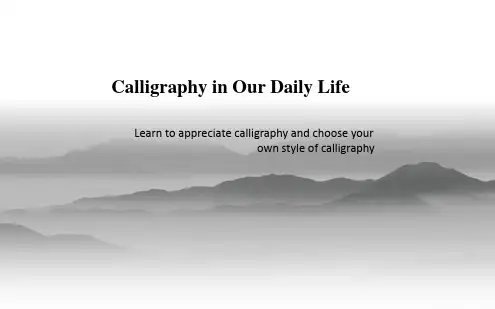
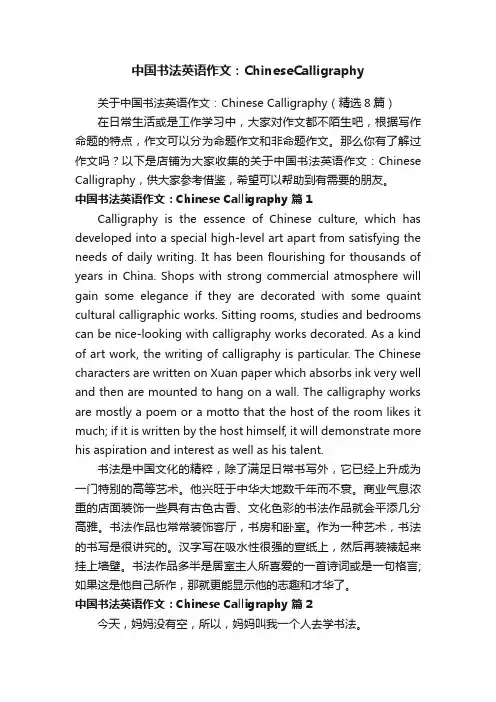
中国书法英语作文:ChineseCalligraphy关于中国书法英语作文:Chinese Calligraphy(精选8篇)在日常生活或是工作学习中,大家对作文都不陌生吧,根据写作命题的特点,作文可以分为命题作文和非命题作文。
那么你有了解过作文吗?以下是店铺为大家收集的关于中国书法英语作文:Chinese Calligraphy,供大家参考借鉴,希望可以帮助到有需要的朋友。
中国书法英语作文:Chinese Calligraphy 篇1Calligraphy is the essence of Chinese culture, which has developed into a special high-level art apart from satisfying the needs of daily writing. It has been flourishing for thousands of years in China. Shops with strong commercial atmosphere will gain some elegance if they are decorated with some quaint cultural calligraphic works. Sitting rooms, studies and bedrooms can be nice-looking with calligraphy works decorated. As a kind of art work, the writing of calligraphy is particular. The Chinese characters are written on Xuan paper which absorbs ink very well and then are mounted to hang on a wall. The calligraphy works are mostly a poem or a motto that the host of the room likes it much; if it is written by the host himself, it will demonstrate more his aspiration and interest as well as his talent.书法是中国文化的精粹,除了满足日常书写外,它已经上升成为一门特别的高等艺术。
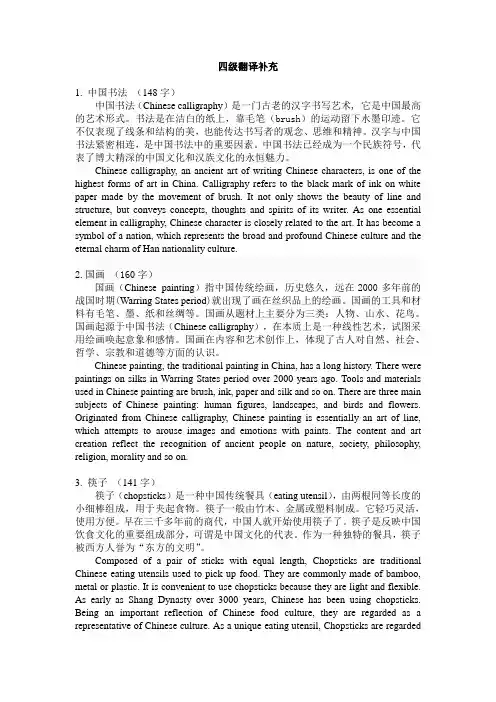
四级翻译补充1. 中国书法(148字)中国书法(Chinese calligraphy)是一门古老的汉字书写艺术, 它是中国最高的艺术形式。
书法是在洁白的纸上,靠毛笔(brush)的运动留下水墨印迹。
它不仅表现了线条和结构的美,也能传达书写者的观念、思维和精神。
汉字与中国书法紧密相连,是中国书法中的重要因素。
中国书法已经成为一个民族符号,代表了博大精深的中国文化和汉族文化的永恒魅力。
Chinese calligraphy, an ancient art of writing Chinese characters, is one of the highest forms of art in China. Calligraphy refers to the black mark of ink on white paper made by the movement of brush. It not only shows the beauty of line and structure, but conveys concepts, thoughts and spirits of its writer. As one essential element in calligraphy, Chinese character is closely related to the art. It has become a symbol of a nation, which represents the broad and profound Chinese culture and the eternal charm of Han nationality culture.2.国画(160字)国画(Chinese painting)指中国传统绘画,历史悠久,远在2000多年前的战国时期(Warring States period)就出现了画在丝织品上的绘画。
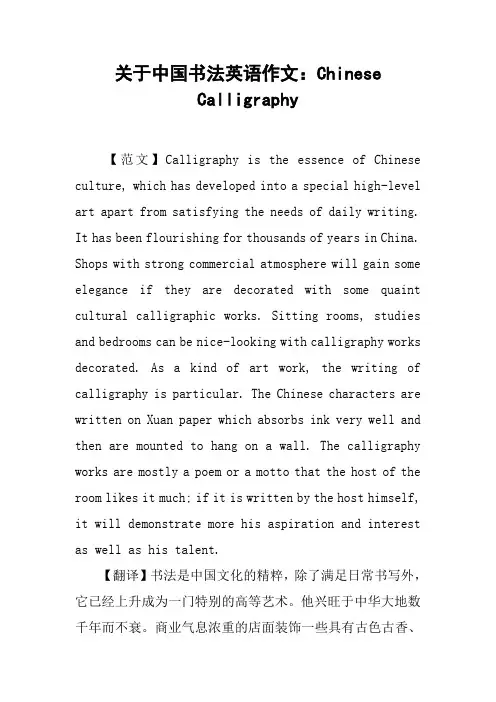
关于中国书法英语作文:ChineseCalligraphy【范文】Calligraphy is the essence of Chinese culture, which has developed into a special high-level art apart from satisfying the needs of daily writing. It has been flourishing for thousands of years in China. Shops with strong commercial atmosphere will gain some elegance if they are decorated with some quaint cultural calligraphic works. Sitting rooms, studies and bedrooms can be nice-looking with calligraphy works decorated. As a kind of art work, the writing of calligraphy is particular. The Chinese characters are written on Xuan paper which absorbs ink very well and then are mounted to hang on a wall. The calligraphy works are mostly a poem or a motto that the host of the room likes it much; if it is written by the host himself, it will demonstrate more his aspiration and interest as well as his talent.【翻译】书法是中国文化的精粹,除了满足日常书写外,它已经上升成为一门特别的高等艺术。
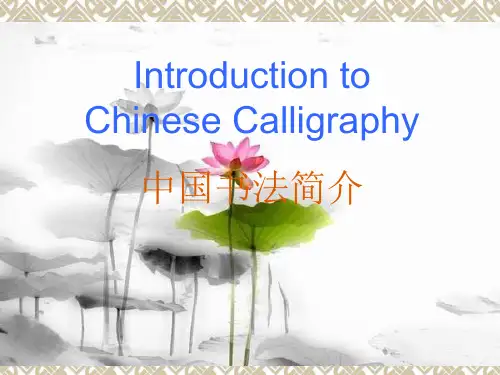
IntroductionChinese calligraphy (Brush calligraphy) is an art unique to Asian cultures. Shu (calligraphy), Hua (painting), Qin (a string musical instrument), and Qi (a strategic boardgame) are the four basic skills and disciplines of the Chinese literati.Regarded as the most abstract and sublime form of art in Chinese culture, "Shu Fa" (calligraphy) is often thought to be most revealing of one's personality. During the imperial era, calligraphy was used as an important criterion for selection of executives to the Imperial court. Unlike other visual art techniques, all calligraphy strokes are permanent and incorrigible, demanding careful planning and confident execution. Such are the skills required for an administrator / executive. While one has to conform to the defined structure of words, the expression can be extremely creative. To exercise humanistic imagination and touch under the faceless laws and regulations is also a virtue well appreciated.By controlling the concentration of ink, the thickness and adsorptivity of the paper, and the flexibility of the brush, the artist is free to produce an infinite variety of styles and forms. In contrast to western calligraphy, diffusing ink blots and dry brush strokes are viewed as a natural impromptu expression rather than a fault. While western calligraphy often pursue font-like uniformity, homogeneity of characters in one size is only a craft. To the artist, calligraphy is a mental exercise that coordinates the mind and the body to choose the best styling in expressing the content of the passage. It is a most relaxing yet highly disciplined exercise indeed for one's physical and spiritual well being. Historically, many calligraphy artists were well-known for their longevity.Brush calligraphy is not only loved and practiced by Chinese. Koreans and Japanese equally adore calligraphy as an important treasure of their heritage. Many Japanese schools still have the tradition of having a student contest of writing big characters during beginning of a new school year. A biannual gathering commemorating the Lanting Xu by Wang Xi Zhi (The most famous Chinese calligrapher in Jin dynasty, ) is said to be held ceremonially in Japan. There is a national award of Wang Xi Zhi prize for the best calligraphy artist. Not too long ago, Korean government officials were required to excel in calligraphy. The office of Okinawa governor still displays a large screen of Chinese calligraphy as a dominating decor.In the West, Picasso and Matisse are two artists who openly declared the influence by Chinese calligraphy on their works. Picasso once said tht if he was born a Chinese, he would have been a calligraphy artist rather than a painter.[This article has been requested by quite a few educational institutes for teaching purpose. To request permission of reproduction, please contact the author at: sllee@ ]Dr. Siu-Leung Lee, the author, is listed among the best calligraphy artists historically by:Tsing Hua University calligraphy webSiteTsing Hua University calligraphy website (another one).Dr. Siu-Leung Lee is author of all translation and calligraphy of Nickelodeon's animated series "Avatar". He is also honored to write the logo calligraphy of the entrance gate of a Chinese National Park.First edition (Apr 2002)Second edition (Sep 2004) Three printings. Sold out。
关于中国书法的英文介绍Chinese calligraphy is an ancient and highly respected art form. It is a form of visual expression that uses strokes, characters, words and phrases to convey an artist’s innermost thoughts and emotions. Chinese calligraphy has a long history, which can be traced back more than 3,000 years.Chinese calligraphy is considered one of the highest forms of visual arts in Chinese culture. In fact, it is so important that it is often seen as a symbol of high social status and educational attainment. The art of Chinese calligraphy originated from the inscription on bones and tortoise shells during the Shang dynasty (16th to 11th century BC). During the Han dynasty (206 BC – 220 AD), the style of writing had already developed significantly, and due to its popularity with the upper classes, it had become government sanctioned and played a role in politics and religion.The four main script styles of Chinese calligraphy are: seal, clerical, running and regular script. Seal script is the earliest script and is still used today on seals, stamps and certain works of art. Clerical script was developed later and was primarily used by scholars and writers. Running script is slightly more modern and became popular during the Song and Tang dynasties. Regular script was developed during the Song dynasty and is the most commonly used script today.Chinese calligraphy has evolved over the centuries and many renowned calligraphers have put their own stamp on the art form. The level of skill achieved by master calligraphers is regarded admirably and highly respected in Chinese society. As such,Chinese calligraphy is regularly displayed in museums and galleries across China to share these masterpieces with the wider public.For those looking to learn this art, the fundamentals are relatively straightforward. Calligraphy is best practiced with brush, ink and paper. However, there are also digital tools available to ensure that calligraphers have access to the materials whenever and wherever they need them. Whether an experienced enthusiast or a novice, anyone can enjoy creating unique and timeless works of art. Therefore, Chinese calligraphy is an elegant and timeless art form with a rich history and culture behind it. It is a skill that requires patience and dedication, but through dedication and practice, even beginners can start to produce beautiful works of art.。
中国书法英语范文Chinese Calligraphy: An Artistic MasterpieceChinese calligraphy is an ancient art form that has captivated the world for centuries. It is a unique and intricate form of visual expression that combines the beauty of written language with the elegance of artistic expression. This ancient art form has evolved over time, reflecting the cultural and historical changes that have shaped the Chinese civilization.At its core, Chinese calligraphy is the art of writing Chinese characters in a visually appealing and aesthetically pleasing manner. The characters themselves are not merely symbols representing words or ideas but are also imbued with a deep cultural and philosophical significance. Each stroke of the brush, each curve and angle, carries with it a wealth of meaning and symbolism.The origins of Chinese calligraphy can be traced back to the earliest days of Chinese civilization, where the written language was seen as a sacred and powerful tool for communication and self-expression. The earliest forms of Chinese writing were carved into oracle bones and bronze vessels, and the development of the art of calligraphywas closely tied to the evolution of the written language itself.Over the centuries, Chinese calligraphy has evolved and diversified, with different styles and schools emerging to reflect the changing cultural and artistic landscapes of China. From the bold and powerful cursive script of the Han Dynasty to the elegant and refined style of the Song Dynasty, each era has left its mark on the art of calligraphy.One of the most distinctive features of Chinese calligraphy is the use of the brush as the primary tool of the art form. The brush, with its flexible and responsive tip, allows the calligrapher to create a wide range of strokes and textures, from the thick and bold to the thin and delicate. The calligrapher's mastery of the brush is a testament to their skill and artistry, as they must carefully control the flow of ink and the pressure of the brush to achieve the desired effect.In addition to the technical mastery of the brush, Chinese calligraphy also requires a deep understanding of the cultural and philosophical underpinnings of the art form. Calligraphers must not only be skilled in the execution of the characters but also in the interpretation and expression of the deeper meanings and symbolism that are inherent in the written language.This understanding of the cultural and philosophical aspects of calligraphy is what sets it apart from other forms of visual art.Calligraphers must not only be skilled in the technical aspects of their craft but also in the ability to convey deeper emotional and spiritual truths through their work.One of the most fascinating aspects of Chinese calligraphy is the way in which it has been influenced by and has in turn influenced other art forms. From the interplay between calligraphy and painting to the integration of calligraphy into the design of everyday objects, the impact of this ancient art form can be seen throughout Chinese culture.In the realm of painting, for example, calligraphy has played a crucial role in the development of traditional Chinese landscape painting. The brushstrokes used in calligraphy have been adapted and incorporated into the painting process, creating a unique and harmonious fusion of visual and textual elements.Similarly, the influence of calligraphy can be seen in the design of everyday objects, from the elegant and understated calligraphic inscriptions on traditional Chinese ceramics to the intricate calligraphic patterns that adorn traditional Chinese architecture.Despite the long and rich history of Chinese calligraphy, the art form continues to evolve and inspire new generations of artists and enthusiasts. In recent years, there has been a growing interest in theart of calligraphy both within China and around the world, as people seek to reconnect with the cultural and artistic traditions of this ancient and revered art form.Whether it is through the study and practice of traditional calligraphic styles or the exploration of new and experimental approaches to the art form, the enduring appeal of Chinese calligraphy lies in its ability to captivate the senses and to inspire deeper reflection on the nature of art, language, and the human experience.In conclusion, Chinese calligraphy is a truly remarkable and multifaceted art form that has left an indelible mark on the cultural and artistic landscape of China and the world. From its humble beginnings as a sacred and powerful tool of communication to its current status as a revered and celebrated art form, the evolution of Chinese calligraphy is a testament to the enduring power of the human spirit to create and to express itself through the written word.。
中国的非物质文化遗产介绍英文段落一:Chinese Calligraphy (中国书法)Chinese Calligraphy, known as "Shufa" in Chinese, is an art form that transcends mere writing. It embodies the harmony between strokes, ink, and paper, reflecting the calligrapher's personality, emotions, and philosophical insights. Each character is a microcosm of balance, rhythm, and vitality, making calligraphy not only a means of communication but also a profound aesthetic experience. As a spiritual pursuit, it has been deeply ingrained in Chinese society for over 3,000 years, fostering virtues such as patience, concentration, and self-cultivation.Chinese Calligraphy (中国书法)Chinese Calligraphy, or “Shufa”in Chinese, transcends mere writing as an art form. It harmoniously unites strokes, ink, and paper, mirroring the calligrapher’s personality, emotions, and philosophical insights. Each character embodies balance, rhythm, and vitality, rendering calligraphy not only a mode of communication but also a profound aesthetic experience. For over 3,000 years,it has been deeply rooted in Chinese society as a spiritual pursuit, nurturing virtues like patience, concentration, and self-cultivation.段落二:Peking Opera (京剧)Peking Opera, or "Jingju" in Chinese, is a theatrical spectacle combining singing, recitation, acting, martial arts, and acrobatics. Its distinctive makeup, costumes, and gestures convey complex characters and narratives, often drawn from historical events, myths, and legends. With a history spanning more than 200 years, Peking Opera has evolved into a national symbol, representing the pinnacle of Chinese operatic art. It continues to captivate audiences worldwide with its vivid storytelling, exquisite music, and profound cultural significance.Peking Opera (京剧)Peking Opera, known as “Jingju” in Chinese, is a theatrical extravaganza integrating singing, recitation, acting, martial arts, and acrobatics. Distinctive makeup, costumes, and gestures convey intricate characters and narratives, often derived from historical events, myths, and legends. Over 200 years old, Peking Opera has becomea national emblem, embodying the apex of Chinese operatic art. It enthralls global audiences with its vivid storytelling, sublime music, and profound cultural import.段落三:Dragon Boat Festival (端午节)The Dragon Boat Festival, or "Duanwu Jie" in Chinese, is a time-honored celebration held annually on the fifth day of the fifth lunar month. It commemorates the ancient poet Qu Yuan and his unwavering loyalty to his country. The festival is marked by vibrant dragon boat races, where teams paddle furiously to the beat of drums, symbolizing attempts to rescue Qu Yuan from the river. Additionally, Zongzi –glutinous rice dumplings wrapped in bamboo leaves –are enjoyed as a traditional delicacy. This festive occasion encapsulates China's respect for history, reverence for ancestors, and commitment to preserving cultural heritage.Dragon Boat Festival (端午节)The Dragon Boat Festival, or “Duanwu Jie” in Chinese, is an age-old celebration observed annually on the fifth day of the fifth lunar month. It honors the ancient poet Qu Yuan and his steadfast devotion to his homeland.Characterized by energetic dragon boat races, where teams paddle in sync with drumbeats, symbolizing efforts to save Qu Yuan from the river, the festival also features Zongzi —glutinous rice dumplings wrapped in bamboo leaves—as a traditional treat. This jubilant event exemplifies China’s respect for history, veneration of ancestors, and dedication to cultural preservation.段落四:Paper-cutting (剪纸)Paper-cutting, or "Jianzhi" in Chinese, is a delicate folk art that dates back to the 6th century. Artists use scissors or knives to intricately cut patterns and images on red paper, symbolizing good fortune and happiness. These vibrant creations, often depicting auspicious symbols, flora, fauna, or scenes from daily life, adorn windows, doors, and walls during festivals or special occasions. Paper-cutting reflects the Chinese people's appreciation for beauty, symmetry, and symbolism, as well as their ability to transform simple materials into extraordinary expressions of cultural identity.Paper-cutting (剪纸)Paper-cutting, or “Jianzhi” in Chinese, is a refinedfolk art with roots dating back to the 6th century. Using scissors or knives, artists skillfully cut intricate patterns and images onto red paper, signifying good luck and joy. Vibrant designs, frequently portraying auspicious symbols, plants, animals, or everyday scenes, embellish windows, doors, and walls during festivals or special events. This artform mirrors the Chinese populace’s admiration for beauty, symmetry, and symbolism, as well as their talent for transforming humble materials into extraordinary manifestations of cultural identity.In conclusion, China's intangible cultural heritage is a treasure trove of artistic expression, historical narrative, and communal spirit. From the graceful lines of calligraphy to the dramatic spectacle of Peking Opera, from the festive traditions of the Dragon Boat Festival to the intricate charm of paper-cutting, each element contributes to the rich tapestry of Chinese culture. These living legacies continue to thrive, evolve, and inspire, serving as vital links to the past while enriching the present and future of Chinese society and humanity at large.总结China's intangible cultural heritage is a wealth ofartistic expression, historical narrative, and communal spirit. Spanning from the elegant strokes of calligraphy to the theatrical grandeur of Peking Opera, from the festive customs of the Dragon Boat Festival to the delicate allure of paper-cutting, each facet adds to the diverse fabric of Chinese culture. These dynamic traditions persist, adapt, and motivate, functioning as crucial connections to the past while enhancing the present and future of both Chinese society and humanity writ large.。
中国书法英文作文Chinese calligraphy is a traditional art form that has a long history in China. It is a unique way of writing that combines both visual aesthetics and linguistic expression. When I see a piece of Chinese calligraphy, I am always struck by the beauty and elegance of the characters. The brushstrokes seem to dance on the paper, creating a sense of harmony and balance. It is truly a form of art that can be appreciated by people from all cultures and backgrounds.Chinese calligraphy is not just about writing characters, it is also about expressing emotions and ideas. Each stroke is carefully planned and executed, reflecting the calligrapher's state of mind at that moment. It is a form of self-expression that is deeply personal and intimate. When I look at a piece of Chinese calligraphy, I can feel the calligrapher's emotions and thoughts, as if they are speaking to me through their brushstrokes.One of the things that I find fascinating about Chinesecalligraphy is the emphasis on rhythm and flow. The brush moves across the paper with a sense of rhythm and grace, creating a visual melody that is both soothing and captivating. It is like a dance between the calligrapher and the brush, a conversation between the artist and the medium. I can almost hear the sound of the brush as it glides across the paper, leaving behind a trail of ink.Chinese calligraphy is also deeply rooted in Chinese culture and history. It is not just a form of art, but a reflection of the Chinese way of life. The characters that are used in calligraphy are not just symbols, but also carry deep cultural and historical meanings. Each stroke is a connection to the past, a link to the rich heritage of China. When I see a piece of Chinese calligraphy, I am reminded of the long and storied history of this ancient civilization.In conclusion, Chinese calligraphy is a beautiful and expressive art form that combines visual aesthetics with linguistic expression. It is a form of self-expression that is deeply personal and intimate. The emphasis on rhythm andflow creates a sense of harmony and balance. Chinese calligraphy is not just a form of art, but also a reflection of Chinese culture and history. It is a unique and fascinating art form that can be appreciated by people from all walks of life.。
中国书法高中英语作文Chinese calligraphy is a traditional art form in China, which has a long history and profound cultural connotations. It is not only a means of recording information, but also a way of expressing emotions and cultivating one's temperament. In the process of practicing calligraphy, people can calm their minds, improve their concentration, and appreciate the beauty of the characters.The charm of Chinese calligraphy lies in its unique artistic conception and expression. Through differentstyles of writing, such as regular script, running script, and cursive script, calligraphers can convey their feelings and thoughts. The strokes and structure of the characters are not only a visual enjoyment, but also a reflection of the calligrapher's personality and inner world.In addition to its artistic value, Chinese calligraphy also plays an important role in promoting cultural exchange and communication. Calligraphy works are not onlyappreciated for their aesthetic appeal, but also serve as a medium for conveying the thoughts and feelings of the calligraphers. Through the appreciation of calligraphy, people can gain insights into the cultural heritage and spiritual pursuits of the Chinese nation.Moreover, Chinese calligraphy has a profound influence on the development of Chinese characters and language. The creation and evolution of calligraphy have greatly enriched the expressive forms of Chinese characters, and have also contributed to the development of literature and art. The beauty and elegance of calligraphy have become an integral part of Chinese culture and civilization.In conclusion, Chinese calligraphy is a unique and valuable cultural heritage that embodies the wisdom and spirit of the Chinese nation. It not only enriches the artistic and aesthetic life of the Chinese people, but also enhances the understanding and communication between different cultures. As a traditional art form, Chinese calligraphy will continue to shine with its timeless charm and appeal.。